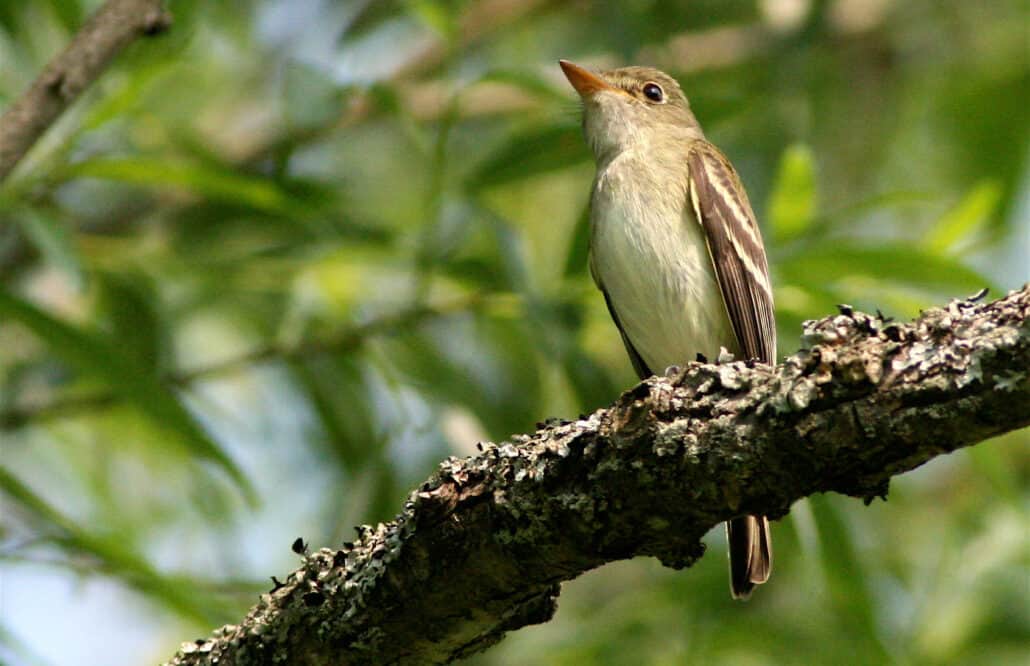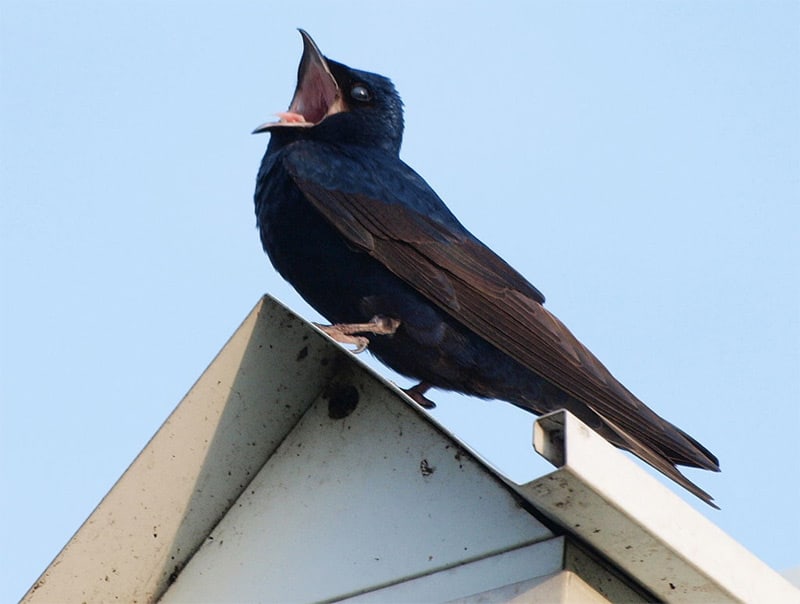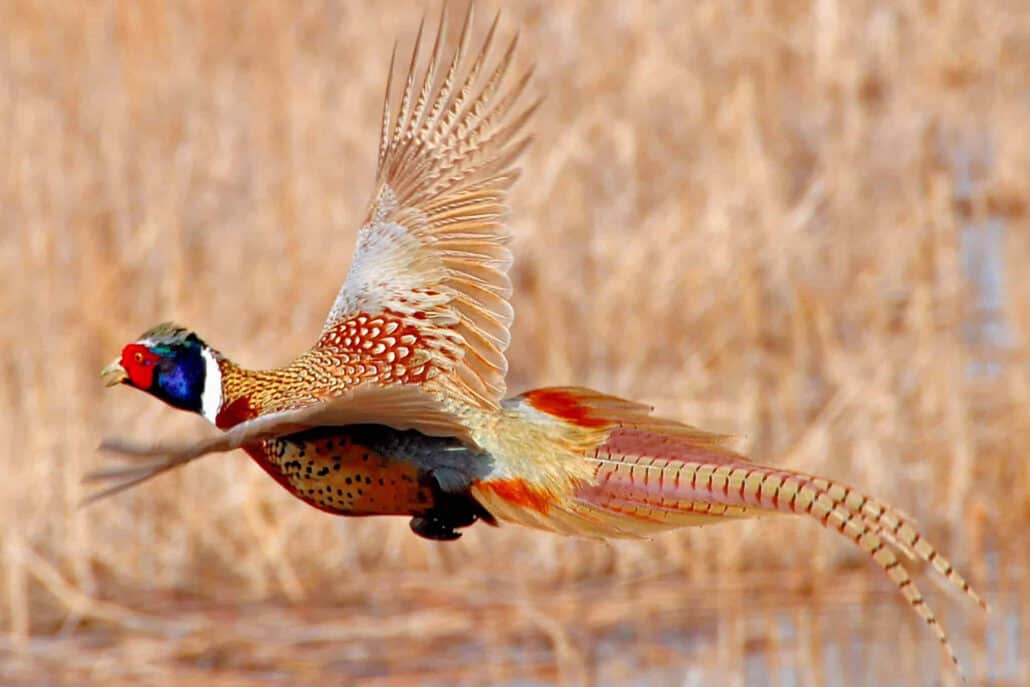Fall birds of Louisiana (September, October, November)
The migration of the flycatcher species of eastern North America peaks in Louisiana during the month of September, when additional species including alder flycatcher, Acadian flycatcher, great-crested flycatcher, and eastern wood-pewee join the least flycatchers already present in the large patches of prickly ash and rough-leaved dogwood. By the end of September, multitudes of migrating brown thrashers and gray catbirds join the flycatchers in seeking out the fruits of these trees. By the end of September, the entire Louisiana supply of prickly ash fruits has vanished, and by the end of October nary a rough-leaved dogwood fruit remains.
Other common migrants in September include blue grosbeak, indigo bunting, and painted bunting, all of which seek out the freshly-matured native grass and weed seeds at the edges of agricultural fields. Yellow warbler is also a common sight during this month, especially within the coastal zone of Louisiana. It seems that migrating yellow warblers head directly for the Gulf Coast during fall migration, and once they hit it, turn west and funnel towards the coastal bend of Texas.
We know this to be a fact because yellow warbler numbers in northern Louisiana remain quite low at this time, while numbers skyrocket within the coastal zone during the same period. The same is true for broad-winged hawks and ruby-throated hummingbirds, both of which peak through Louisiana’s coastal zone in late September and early October. During periods of fair weather, when high pressure systems dominate the western Gulf Coast, tens of thousands of broad-winged hawks may be counted in a single day along the extreme southwestern coast of the state. Like most raptors, these hawks are diurnal (day time) migrants, setting down into riparian forests to roost at night, then “kettling up” to migrating altitude the following morning.
The bulk of migrating shorebirds passes through Louisiana in September and October as well. During this time a visit to any of the state’s many recently harvested agricultural fields can produce a substantial list of sandpipers and allies, including yellow rail, black-bellied plover, semipalmated plover, greater yellowlegs, lesser yellowlegs, solitary sandpiper, ruddy turnstone, sanderling, semipalmated sandpiper, western sandpiper, least sandpiper, dunlin, stilt sandpiper, short-billed dowitcher, long-billed dowitcher, and Wilson’s snipe.
The third week of October signals the peak of neotropical songbird migration through Louisiana. During this time, and for several weeks prior, numerous species of vireos, thrushes, and tanagers can be found on a daily basis, congregated around fruiting trees and shrubs—especially sassafras, black gum, native magnolias, flowering dogwood, Carolina buckthorn, strawberry bush, American beautyberry, native viburnums, Virginia creeper and wild grapes. For their part, warblers move stealthily through most all of Louisiana’s forests, seeking out adult moths and other insects. Their muted post-breeding plumages render them much more difficult to detect than during spring migration. Nevertheless, they are present in large numbers through September and October.
By the end of October, the vast majority of the neotropical migrants have departed, making room for a whole host of neararctic migrants which will spend the winter basking in Louisiana’s warm sun and feasting on the state’s copious supply of seeds, fruits, and aquatic life. November usually signals the arrival of species such as sharp-shinned hawk, red-tailed hawk, northern harrier, peregrine falcon, merlin, American kestrel, yellow-bellied sapsucker, eastern phoebe, blue-headed vireo, house wren, winter wren, sedge wren, golden-crowned kinglet, ruby-crowned kinglet, hermit thrush, American pipit, cedar waxwing, orange-crowned warbler, yellow-rumped warbler, palm warbler, field sparrow, vesper sparrow, savannah sparrow, Henslow’s sparrow, LeConte’s sparrow, fox sparrow, song sparrow, Lincoln’s sparrow, swamp sparrow, white-throated sparrow, white-crowned sparrow, dark-eyed junco, and American goldfinch.
Toward the end of November huge numbers of geese, ducks, and blackbirds arrive to spend the winter in Louisiana. Agricultural lands and natural marshes are preferred sites for these birds. Flocks of thousands of ducks, tens of thousands of geese, and millions of blackbirds are not uncommon sights throughout much of the state in November through January. Common goose species include snow goose, Ross’s goose, and greater white-fronted goose, with occasional pockets of Canada goose.
The duck list is long, involving the majority of North American species. Especially common are wood duck, gadwall, American wigeon, mallard, blue-winged teal, northern shoveler, northern pintail, green-winged teal, canvasback, redhead, ring-necked duck, lesser scaup, hooded merganser, and ruddy duck. Blackbirds tend to congregate in mixed flocks composed of European starling, red-winged blackbird, Brewer’s blackbird, common grackle, and brown-headed cowbird. Occasionally—especially in mid- to late November—large pure flocks of boat-tailed grackle and great-tailed grackle number in the tens of thousands can be observed milling about in the rice fields of Lousiana’s coastal zone.
Fall can be quite hectic, with lots of backyard traffic. Common backyard migrants include vireos, thrushes, brown thrashers, and gray catbirds, as well as buntings, tanagers, and orioles. All these birds welcome fruit in their diets at this time. Some of the more dependable fruit sources for fall migrants are native magnolias, dogwoods, and viburnums, plus other species like spicebush, sassafras, redbay, American beautyberry, strawberry bush, Carolina buckthorn, elderberry, pokeberry, and native vines such as Virginia creeper and wild grapes.
Consider also planting natural seed sources for migrating buntings and sparrows. Some of the prettiest examples include big bluestem, eastern gamagrass, compass plant, purple coneflower, black-eyed susan, and other coneflowers.




